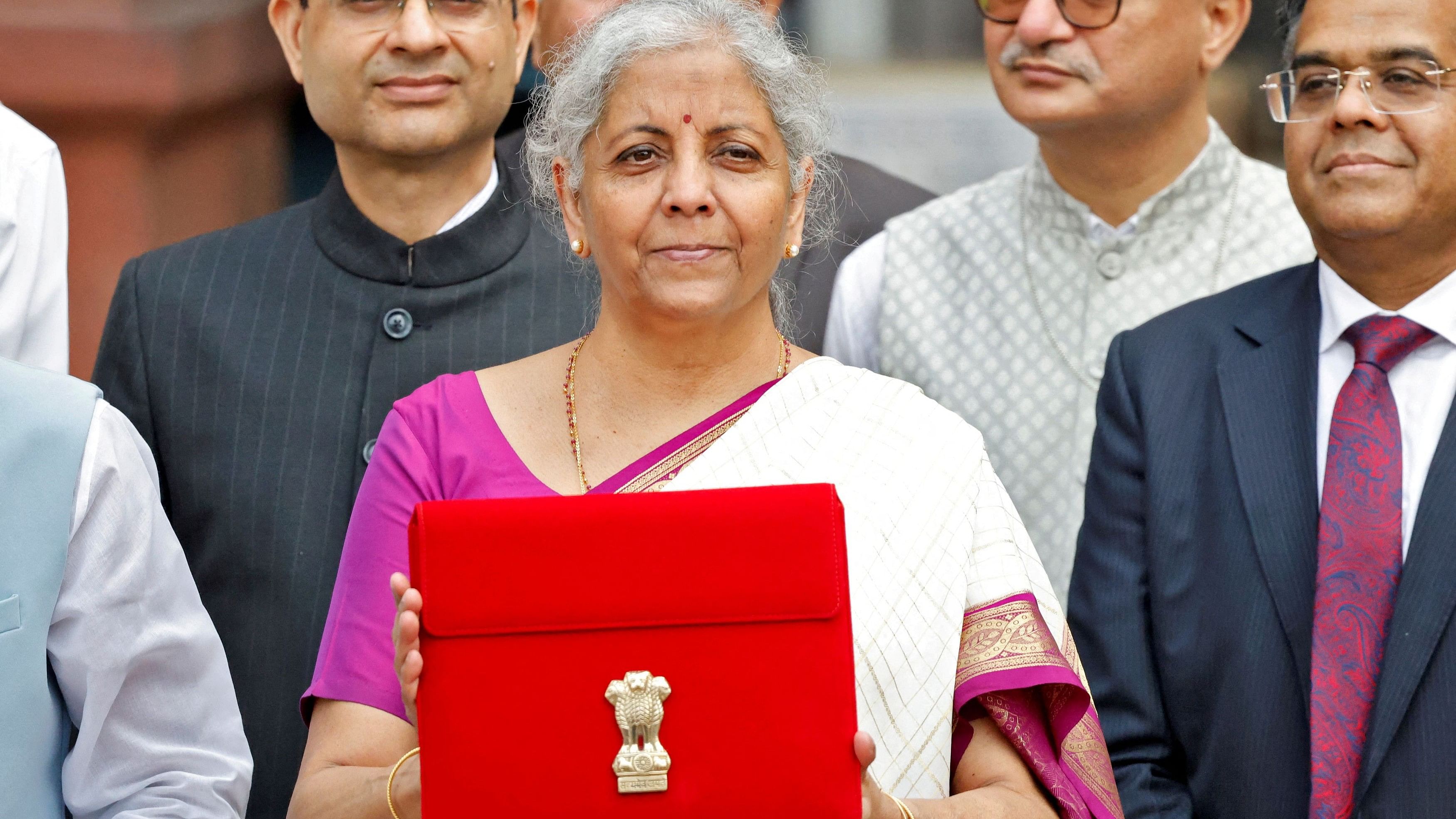
Finance Minister Nirmala Sitharaman holds up a folder with the Government of India's logo, in New Delhi, on Tuesday
Credit: Reuters Photo
This Union Budget reminds us that a Budget is an overall roadmap towards macro-economic development and sustainability rather than a mere listing of tax tweaks. While the tax proposals form an important part of the Budget and do impact the ordinary citizen, the responsibility and accountability of the government to its citizens is better demonstrated by how the taxpayers’ money is going to be spent. As expected, the Budget did have specific packages for Bihar and Andhra Pradesh, besides Odisha.
The theme of the Budget was employment, skilling, MSMEs, and the middle class. The nine priority areas: agriculture, employment, inclusive development, manufacturing and services, urban development, energy security, infrastructure, innovation, and next-gen reforms, show a balanced consideration of the needs of various sectors of the economy.
Particularly, the three schemes for employment-linked incentives are laudable. Contributing one month's wage to new entrants in all formal sectors in three instalments of up to ₹15,000 is expected to benefit 21 million youth. The proposal to reimburse EPFO contributions of employers up to ₹3,000 per month for two years for all new hires is certainly welcome. The proposal linked to first-time employees incentivises both employee and employer for EPFO contributions in the specified scales for the first four years and is expected to help 3 million youth.
Wealth is created not by merely saving money but by earning more. Here skilling becomes very important; about 2 million youth are expected to be skilled over five years. If implemented in its true spirit, this will mean enhanced livelihood for the young adult population.
Setting up working women hostels in collaboration with industry, and establishing creches will hopefully bring up the lulled female labour force participation rate. Keeping up the rate is important from the perspective of societal equity not just for the current generation but for the generations to come too. Besides this, an allocation of Rs 3 lakh-crore for women-centred schemes is appreciated.
Perhaps stating the middle class specifically in the theme had the markets waiting for more dramatic tax relaxations. However, there was something to take home from the Budget. As far as direct taxes are concerned, the standard deduction which is allowed for salary has been increased from Rs 50,000 to Rs 75,000. This is in line with the expectations, but it may not be seen as sufficient when compared to the price rise. The family pension standard deduction is also increased from Rs 15,000 to Rs 25,000. All these are for the new regimes. The slabs under the new regime have been tweaked resulting in savings of up to Rs 17,500.
In line with the Interim Budget proposals, the Prime Minister Surya Ghar Muft Bijli Yojana which aims at installing rooftop solar plants to enable 10 million households to obtain free electricity up to 300 units every month will benefit the public and enable them to do their share towards arresting global warming. The allocation of Rs 10 lakh-crore under the Pradhan Mantri Awas Yojana is expected to further the goal of ‘Housing for All’.
The proposals on changing the long-term capital gains (LTCG) tax to 12.5%, which is up from 10% on listed equity shares and equity funds, and down from 20% on other assets, and short-term capital gains tax on listed shares and equity funds at 20% up from 15%, for prospective transfers have indeed been unexpected. The increase in exemption limit for the LTCG tax on listed equity shares from Rs 1 lakh to Rs 1.25 lakh is a minor relief. The proposal to tax buyback of securities, while expected, will leave investors wanting for more when it is clear that it will be taxed like dividends, at slab rates.
Companies can cherish the abolition of the angel tax regime and look forward to the reforms in foreign direct investment, overseas investment regime, and the insolvency resolution regimes.
Overall, this Budget may be seen as a step towards macroeconomic development and achieving fiscal stability.
(Usha Ganapathy Subramanian is a practising company secretary, and Ranjith Krishnan is a sustainability consultant)
Union Budget 2024 LIVE | Making a record for any Finance Minister, Nirmala Sitharaman presented her 7th consecutive Union Budget on July 23, 2024 under the Modi 3.0 government. This Budget brought tax relief for the middle class, while focusing on jobs through skilling, incentivising employers. Track the latest coverage, live news, in-depth opinions, and analysis only on Deccan Herald. Also follow us on WhatsApp, LinkedIn, X, Facebook, YouTube, and Instagram.